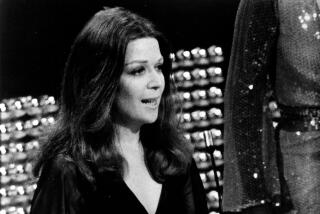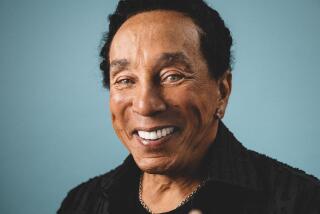COMMENTARY : ‘RETURN TO MAYBERRY’: THE MYTH ENDURES
- Share via
Mayberry--in 1986 or 1968--Is a Make-Believe Land of Never-Was Where Blacks Are Invisible and the Women Are Subservient or Deferential Last Sunday’s much-ballyhooed movie of the week, “Return to Mayberry,” starring Andy Griffith and surviving members of the long-running 1960s series, evidently struck a responsive chord among the nation’s viewers, racking up the second highest Nielsen showing for last week with a hefty 33 rating and a 49% audience share (second only to the Bill Cosby show, which had a 34.6 rating and a 53% share). For a series that placed consistently in the Top 10 in a period of stress and strife, it is not that surprising that a “Mayberry” reunion broadcast in the 1980s atmosphere of smug quiescence should do so well, now that we are frankly celebrating the bland, homogenized world it depicted.
Watching “The Andy Griffith Show,” redux or rerun, is like snoozing on a porch rocker after a big Sunday dinner. Yet for all its gentle humor and comforting entertainment value, Mayberry--in 1986 or 1968--is a make-believe land of never-was, a kind of nostalgic American Brigadoon.
Television has always marketed myths, shaving off the unpleasant edges of reality to make the sitcom images on the small screen acceptable to advertisers and audiences. But these marriages of convenience between commercialism and wishful thinking should, even in retrospect, be judged for what they did.
The South portrayed in the series was not Mayberry, take it from me. For nearly 20 years I lived in the neighborhood. The town created by the series is a deceptive vision of whites-only, conservative society where traditional values were never challenged. More than anything else, the show served as a cultural and political palliative in troubled times.
As Richard Kelly observes in his excellent paperback, “The Andy Griffith Show” (Blair, Winston-Salem, 1981), “Because the war in Southeast Asia and the racial and student riots of the ‘60s were running simultaneously against the ‘Griffith Show,’ it is little wonder that a town like Mayberry was so appealing.”
While the civil rights movement swept the rural South, television was constructing sharply contradictory stereotypes: At the dinner hour, network news was offering hostile Southern sheriffs, beating and hosing down demonstrators; in prime time, CBS served up affable, amiable Sheriff Andy Taylor, resolving all discord with humor and sensitivity.
White Southerners have complained for years of being afflicted by negative caricatures, from “Tobacco Road” to “The Dukes of Hazzard.” But no single piece of popular culture since “Birth of a Nation” or “Gone With the Wind”--equidistant from reality--did so much to create and crystallize an idealized image of the American South as “The Andy Griffith Show” and its spinoffs, “Mayberry, R.F.D.” and “Gomer Pyle: USMC.”
Like the others, the myth of Mayberry was rooted in reality, based on life in Griffith’s birthplace, Mt. Airy, N.C., just below the Virginia border. Andy Griffith’s name is on the community playhouse and his visage still smiles down from a mural outside the old bus station.
Kelly, in his admiring and sympathetic study, points out that “Mayberry mirrors the best qualities of any small town. Despite the constant reminders that the setting is North Carolina, Mayberry is really Small Town U.S.A.”
And, because it is so reassuring, that myth endures. Syndicated reruns, begun while the series were still in production, are still afternoon mainstays throughout the nation, and with good reason: Small Town, Mayberry, U.S.A.--interiors shot at Culver City, exteriors in Franklin Canyon--lacked not only racial unrest during this period; more fundamentally, in 250 episodes there was not one single black person.
Except in a relatively few areas of Appalachia, there is no rural South without black people. In real life, a highly visible percentage of Mt. Airy’s 7,000 citizens were and are black, and the local high school admitted its first black student, a football star, in 1965. Throughout the decade there was a vigorous chapter of the NAACP.
(In 20 years, to judge from Sunday night’s show, Mayberry has changed very little. It looked a lot more like Northern California, where it was filmed, than North Carolina. Reality seems to have made few inroads, evidenced by five mute black faces scattered here and there in the crowd shots.)
Mayberry was certainly not the first fictional locale where blacks were invisible men and women. But such outrageous invisibility in such an indelibly biracial society was clearly a matter of choice, and cannot be blamed on the limitations of television. At the same time Sheldon Leonard was producing “The Andy Griffith Show,” which broke no ground in acknowledging the rapidly changing realities of the South, he was turning out “I Spy,” the Emmy-winning series that featured Bill Cosby.
And race was not the series’ only blind spot.
When a woman pharmacist, played by Elinor Donahue, came to Mayberry as Andy’s love interest, running for (and winning) a city council seat and saving a farm girl from an overprotective father, she lasted only six episodes. Subsequently, all successful women characters were subservient or deferential.
“We never knew how to write for women,” Griffith confessed to Kelly, nor, he said, were they willing to grapple with any social issues. “In those days, in television, we had a tough time talking about anything unless we talked about what we were going to take on a picnic. That was always a problem; we couldn’t talk about anything that we really might like to, as they can today.”
As Kelly points out, “One reason that innocence and stability prevail in Mayberry is the absence of sexuality. . . . The subject of sex had to be played down, not only because of the television ethics of the ‘60s, but more importantly because it would destroy the illusion of innocence that lies at the very heart of Mayberry.”
One of the classic routines of the series takes place when Don Knotts, as Deputy Barney Fife, explains to Andy his big plans for the evening: “I’m gonna go home, take a shower, go over to Thelma Lou’s and watch a little TV.”
A favorite television staple in Piedmont North Carolina throughout the 1960s was a mean-spirited local television editorialist who railed each night on a Raleigh station against civil rights, the emerging women’s movement, “sexual perversion,” Israel, Medicare and Social Security. He was Jesse Helms, the product of yet another small North Carolina town, and pandering to the worst instincts of his viewers. In return, his North Carolina constituency elected him to the U.S. Senate. Twice. This is no coincidence either. As Kelly notes, “The basic principle of Mayberry (is) that what is natural and good must not change. The comic conventions of the Griffith show impose the reassuring patterns of order and stability. . . . The fundamental appeal of the show is that it produces out of the confusing world we have to live in a vision of a simple world we would like to live in, namely, Mayberry. . . . Mayberry is totally conservative, and its people revel in its traditions.”
The Mayberry myth was so persuasive that, in the early 1970s, Frances Bavier, a native New Yorker who played the venerable Aunt Bea for 11 years, on both “The Andy Griffith Show” and its successor, “Mayberry, R.F.D.,” retired to Siler City, N.C. She has since become a virtual recluse, and in one of her few telephone interviews over the last 10 years, told a local newspaper that moving to rural North Carolina--a move based on her experience with the series--was one of the worst mistakes she has ever made. In Sunday’s TV reunion, Andy paid his respects to Aunt Bea in the cemetery.
More to Read
The complete guide to home viewing
Get Screen Gab for everything about the TV shows and streaming movies everyone’s talking about.
You may occasionally receive promotional content from the Los Angeles Times.






